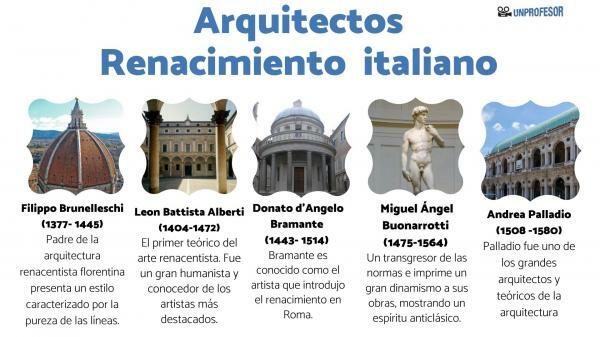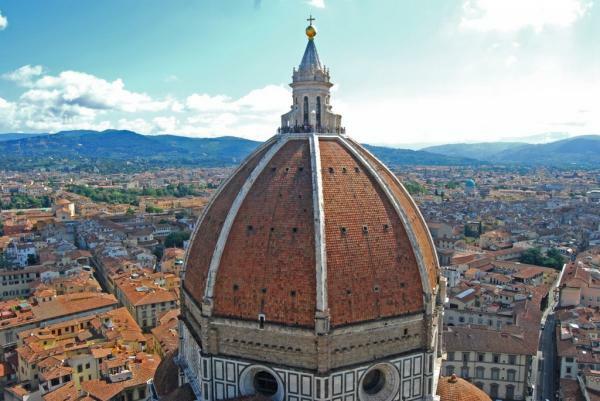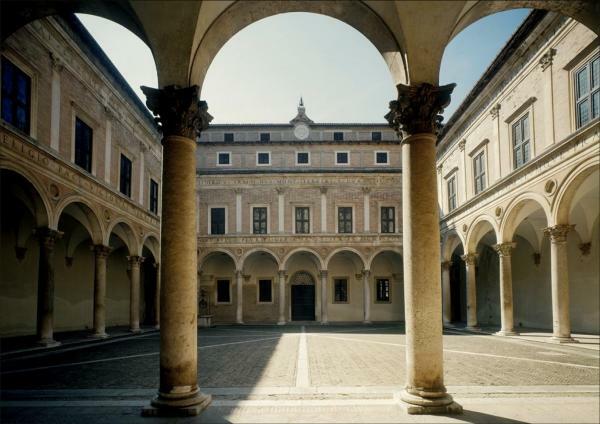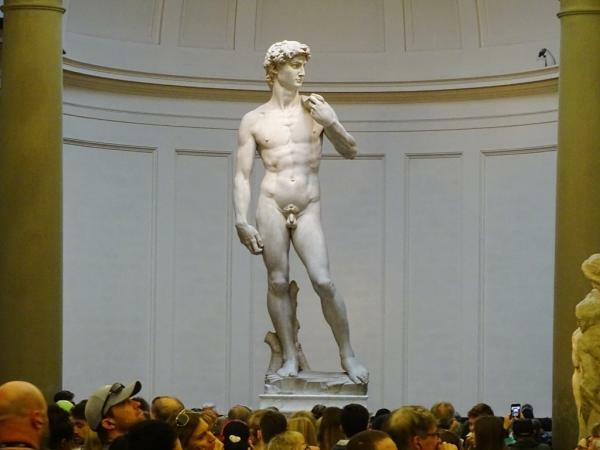5 best ARCHITECTS of the ITALIAN Renaissance and their works

The XV century witnessed a spectacular growth of Italian cities. Some prosperous cities thanks to the benefits of banking and commerce and materializing in the construction of numerous buildings in which the aesthetic ideals of Renaissance.
In this lesson from unPROFESOR.com we offer you a list of the best Italian Renaissance architects and their works so that you know who are the main figures of this artistic movement and their trajectory.
Index
- Filippo Brunelleschi (1377-1445)
- Leon Battista Alberti (1404-1472)
- Donato d'Angelo Bramante (1443 / 1444-1514)
- Michelangelo Buonarrotti (1475-1564)
- Andrea Palladio (1508-1580)
Filippo Brunelleschi (1377-1445)
We start this list of the best architects of the Italian Renaissance to talk about Brunelleschi, father of Florentine Renaissance architecture, that presents a style characterized by the purity of the lines, the simplicity and the harmony in the distribution of the volumes in the space.
Thus, Brunelleschi was the
most important architect of the 15th century marking his work a turning point from Gothic to Renaissance, being the dome of the Florence Cathedral the architectural work that marks that change. Although the work is not purely Renaissance, since it was originally Gothic constructive concepts, for its construction, Brunelleschi analyzed the characteristics of Roman architecture to build a masonry dome of large dimensions.Works by this Italian Renaissance architect
- The Florence cathedral, begun in 1296, saw the construction of its Dome for more than a century when not solving how to support the great weight of the vault. Brunelleschi, a goldsmith and sculptor, became interested in this question in 1404, turning to his study in 1417. Thus, the dome is formed by a series of vertical pointed ribs that are joined transversely by eight horizontal ribs. In this way the weight of the masonry is lightened, following a technique inspired by ancient Roman architectural works.
- After this work, the first truly Renaissance construction is the Hospital of the Innocents of Florence. This work designed by Brunelleschi has some inspiration in the Hospital de San Antonio de Lastra a Signa. The building consists of a luminous colonnade on the lower floor, with Corinthian columns supporting the upper floor. A floor in which windows are opened finished off by a molded roof. The lighting of the rooms on the ground floor was solved with a reduction of the supporting structures of the loggia, following the module based on the use of the vault and the cube. A design that stems from Roman architectural heritage, although with proportions that add lightness to the arches and columns.
- This pattern was also repeated in the Florentine Basilica of San Lorenzo, also directed by Brunelleschi. The floor plan of this basilica is inspired by medieval models such as Santa Croce or Santa María Novella, with a Latin cross, three naves and shallow side chapels. The colonnades of the naves and the vaults without ribs in the diagonals provide lightness to the supporting structure of the complex.
- Another of his works, with a Latin cross plan, but more classicist, is the Basilica of Santo Spirito (1428-1432). A work with semi-circular side chapels that extend evenly, without signs of the Gothic. His fully Renaissance work is the Rotonda di Santa Maria degli Angeli, (1434 -1437) and unfinished, it is inspired by the temple of Minerva Medica, with an octagonal plan with radial chapels.

Leon Battista Alberti (1404-1472)
Leon Battista Alberti he was another of the most important Italian Renaissance architects. He was an architect and first theorist of renaissance art.
Genovés, Alberti was a great humanist and connoisseur of the most outstanding artists of the first Renaissance, from Brunelleschi to Donatello or Masaccio. A job that led him to write a treatise on painting, in addition to writing his own treatise on Architecture, Of rebuilding (1443), after studying the work of Vitruvius and the ancient ruins from Roman times.
His work
- One of his works the Rucellai Palace, It is inspired by the Roman Colosseum with three orders of pilasters on different levels.
- Alberti worked on the reconstruction of the church of San Francesco, the so-called TMalatestian emplo, being also his works the churches of San Sebastián and Sant’Andrea.
- In terms of civil architecture, Alberti worked on the buildings in Pienza, one of the first architectural and urban reorganizations in the history of the Renaissance.

Donato d'Angelo Bramante (1443 / 1444-1514)
Bramante is known as the artist who introduced the Rbirth in Rome. This artist brought to this city all architectural innovations from northern Italy after training in the Urbino workshops, one of the artistic capitals of the Quattrocento. But, with his sober and elegant designs, Bramante broke with the architectural tradition of that period.
Thus, while Brunelleschi created single vision buildings, that is, the viewer only has one point of view of the building, Bramante multiply perspectives, conceiving the building as a sculpture. Bramante's architectural style is characterized by severity and the use of a central plant covered with a dome.
His work
Among his works are:
- The temple of San Pietro in Montorio
- The so-called Palace of the Popes
- The project of the new Basilica of Saint Peter of the Vatican, the latter project that only got to start and which would later be continued and modified by Rafael, Antonio de Sangallo and Miguel Ángel, ending in the s. XVII by Carlo Maderno.

Michelangelo Buonarrotti (1475-1564)
We continue to discover the most important Italian Renaissance architects to talk about an essential one: Miguel Angel. He introduces himself as a rule breaker and gives a great dynamism to his works, showing an anti-classical spirit and a deeply tragic feeling.
The artist also introduced the colossal order with designs in which huge pilasters are introduced, combining the scale of the temple with smaller spaces in order to turn the architectural space into something monumental.
The best known works of Michelangelo
When Michelangelo undertook his first architectural work in 1516, the artist had already carried out works such as the David or the frescoes of the Sistine Chapel.
Such was his fame that he was commissioned by Pope Leo X to carry out a project for the facade of the florentine church of San Lorenzo, family temple of the Medici. A project that the artist enriched by introducing a large number of sculptures as a way of representing a universe in which the human body and the architectural framework appear integrated. The project was not carried out and he went on to carry out a new work, the sacristy of the church of San Lorenzo.
In this work the basic characteristics of his style are already appreciated. Thus, one of the most striking signs is the architectural decoration of the walls, in addition to offering a new dimension to the classical standards. Miguel Ángel manages to create numerous effects, one of the great examples being the ricetto of the Laurentian Library and the magnificent staircase in the lobby. In this work, Miguel Ángel manages to reinforce verticality and three-dimensionality and offer more majesty and roundness to the stairs.

Andrea Palladio (1508-1580)
Palladio was one of the great architects and architectural theorists, being one of the most prominent designers of the Republic of Venice. He was the author of the work of numerous villas, churches and palaces with a very personal style, in which the classical repertoire is combined. Public The four books of architecture (1570) and his style, the palladianism, inspired architects of later centuries.
Works by this Italian Renaissance architect
Among his most outstanding works are:
- The restoration of the Palazzo della Ragione in Vicenza, known as the Basilica Palladiana
- The Palazzo Chiericati,
- The Pojana, Forni Cerato, Godi, Pisani and Cornaro villas
- The Barbaro, Badoer and Emo villas
- Although the most successful is the Villa Almerico Capra, one of the first secular constructions of the modern era that had as its front a front of a classical temple.
- Basilica of San Giorgio Maggiore
- Iglesia del Redentor, with an intelligent solution to the double problem of adapting an old basilica to a place of Christian worship, the so-called “double temple” facades.

If you want to read more articles similar to Italian Renaissance architects and their works, we recommend that you enter our category of Story.
Bibliography
- Wittkower, R, (1995) The foundations of architecture in the Age of Humanism, Alianza Editorial
- Baccio, Maria Bacci (2005) The stone sky: Brunelleschi and the great dome, S.L Velecio Editores
- Marton, P, (2008) Palladio: Complete Architectural Work, Taschen Benedikt


